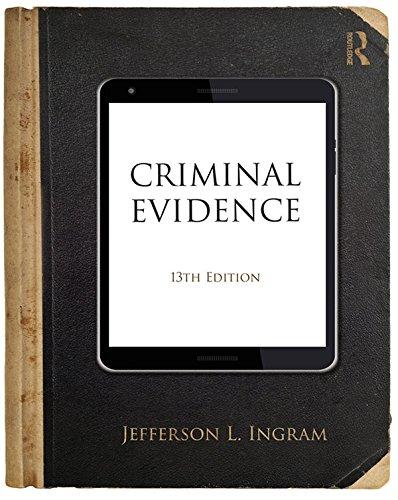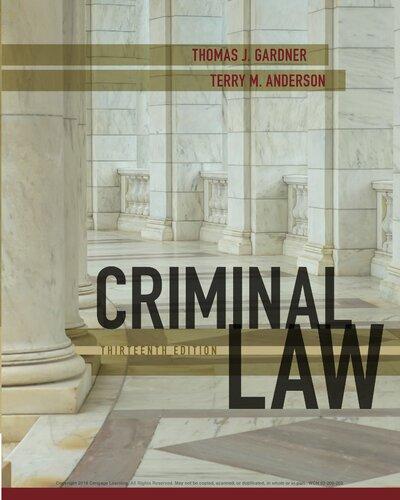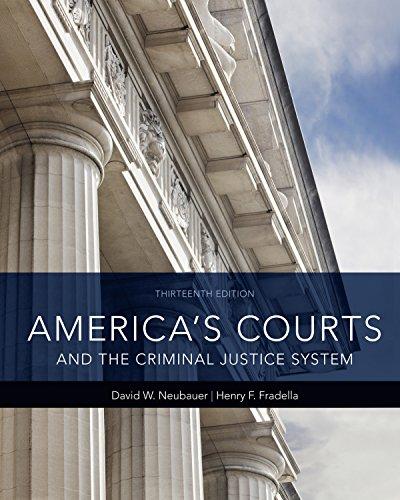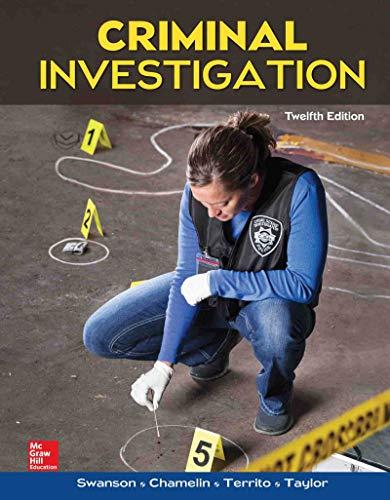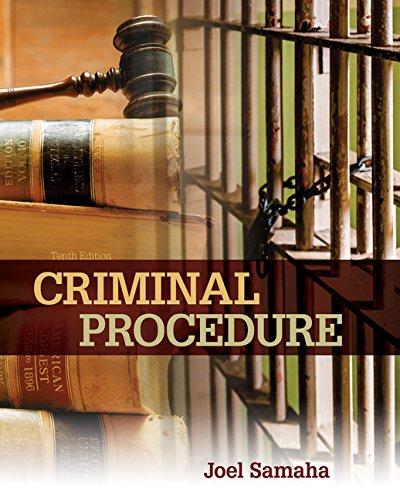Criminal Evidence 13th Edition, (Ebook PDF)
Visit to download the full and correct content document: https://ebookmass.com/product/criminal-evidence-13th-edition-ebook-pdf/
More products digital (pdf, epub, mobi) instant download maybe you interests ...
Criminal Evidence: Principles and Cases 9th Edition, (Ebook PDF)
https://ebookmass.com/product/criminal-evidence-principles-andcases-9th-edition-ebook-pdf/
(eBook PDF) Criminal Justice: A Brief Introduction 13th Edition
https://ebookmass.com/product/ebook-pdf-criminal-justice-a-briefintroduction-13th-edition/
Criminal Law 13th Edition Thomas J. Gardner
https://ebookmass.com/product/criminal-law-13th-edition-thomas-jgardner/
America’s Courts and the Criminal Justice System 13th Edition – Ebook PDF Version
https://ebookmass.com/product/americas-courts-and-the-criminaljustice-system-13th-edition-ebook-pdf-version/
Criminal Justice Today: An Introductory Text for the 21st Century 13th Edition, (Ebook PDF)
https://ebookmass.com/product/criminal-justice-today-anintroductory-text-for-the-21st-century-13th-edition-ebook-pdf/
Criminal Investigation 11th Edition PDF (eTextbook)
https://ebookmass.com/product/criminal-investigation-11thedition-pdf-etextbook/
Criminal Investigation 12th Edition, (Ebook PDF)
https://ebookmass.com/product/criminal-investigation-12thedition-ebook-pdf/
Criminal Procedure 10th Edition, (Ebook PDF)
https://ebookmass.com/product/criminal-procedure-10th-editionebook-pdf/
Criminal Investigation 5th Edition, (Ebook PDF)
https://ebookmass.com/product/criminal-investigation-5th-editionebook-pdf/
5.9JudicialNoticeofLaws
510–LawoftheForum
511–FederalLaw
512–LawofSisterStates
5.13–LawofForeignCountries
514–MunicipalOrdinances
515–AdministrativeRegulations
516–JurisdictionofCourts
5.17JudicialNoticeProcess
5.18JudicialNoticeinCriminalCases
519Summary
Chapter6 Presumptions,Inferences,andStipulations
61Introduction
6.2DefinitionsandDistinctions
63ReasonsforPresumptionsandInferences
64PresumptionsofLaw
65PresumptionsofFact
66ClassesofPresumptions
67SpecificPresumptionSituations
68–Innocence
69–Sanity
610–Suicide
611–PossessionofFruitsofCrime
612–ThataPersonIntendstheOrdinaryConsequencesofHisorHerVoluntaryActs
613–KnowledgeoftheLaw
614–FlightorConcealment
615–UnexplainedAbsenceasDeath
616–RegularityofOfficialActs
617ConstitutionalityTestsforPresumptionsandInferences
618Stipulations
6.19–PolygraphTests
620Summary GeneralAdmissibilityTests
Chapter7 RelevancyandMateriality
71Introduction
7.2RelevancyDefined
73AdmissibilityofRelevantEvidence
74ReasonsforExclusionofRelevantandMaterialEvidence
75RelevancyofParticularMatters
7.6–IdentityofPersons
77–IdentityofThings
78–CircumstancesPrecedingtheCrime
79–SubsequentIncriminatingorExculpatoryCircumstances
7.10–Defenses
7.11–CharacterEvidence
712–ProofofOtherCrimes,Wrongs,orActs
713–ExperimentalandScientificEvidence
7.14–RelevancyofCybercrimeEvidence
7.15Summary
Chapter8
CompetencyofEvidenceandWitnesses
81Introduction
82Definitions
83GeneralCategoriesofIncompetentEvidence
84CompetencyofEvidenceDocumentaryEvidence
85–TestsandExperiments
86–ConductofTrainedDogs
87–TelephoneConversations
88NegativeEvidenceasCompetentEvidence
89EvidenceCompetentforSomePurposesbutNotforOthers
810CompetencyofWitnesses
811–MentalIncapacity
812–Children
813–HusbandandWife
814–ConvictionofCrime
815–ReligiousBelief
8.16CompetencyoftheJudgeasaWitness
817CompetencyofaJurorasaWitness
818Summary
EvidenceviaWitnessTestimony
Chapter9
ExaminationofWitnesses
9.1Introduction
92EssentialQualitiesofaWitness
93OathorAffirmationRequirement
94JudicialControlofTestimony
9.5SeparationofWitnesses
96DirectExaminationofWitnesses
97–LeadingQuestions
98–RefreshingMemoryPresentMemoryRevived
9.9–PastRecollectionRecorded
9.10Cross-ExaminationofWitnesses
911RedirectandRecross-Examination
912ImpeachmentofWitnesses
9.13–OwnWitness
9.14–BiasorPrejudice
915–CharacterandConduct
916–ConvictionofCrime
9.17–PriorInconsistentStatements
9.18–DefectsofRecollectionorPerception
919–UseofConfessionforImpeachmentPurposes
920RehabilitationofWitness
9.21Summary
Chapter10 Privileges
101Introduction
102ReasonsforPrivilegedCommunications
103CommunicationsBetweenSpouses
104CommunicationsBetweenAttorneyandClient
105CommunicationsBetweenPhysicianandPatient
106CommunicationstoClergy
107ConfidentialInformantPrivilege
108StateSecretsandOtherOfficialInformation
10.9NewsMedia–InformantPrivilege
1010Summary
Chapter11 OpinionsandExpertTestimony
111Introduction
11.2DefinitionsandDistinctions
11.3AdmissibilityofNonexpertOpinions
114SubjectsofNonexpertOpinions
115OpinionsofExperts
116QualificationsofanExpert
11.7SelectionofExpertWitness
118ExaminationofExpertWitness
119Cross-ExaminationofExpertWitness
1110SubjectsofExpertTestimony
11.11ExpertsFromCrimeLaboratories
11.12Summary
Chapter12 HearsayRuleandExceptions
121Introduction
122DefinitionsandStatementoftheHearsayRule
12.3HistoryandDevelopmentoftheHearsayRule
124ExceptionstotheHearsayRuleGeneral
125–SpontaneousandExcitedUtterances
126–BusinessandPublicRecords
127–FamilyHistoryandRecords(Pedigree)
128–FormerTestimony
129–DyingDeclarations
1210–DeclarationsAgainstInterest
1211–OtherExceptionsResidualExceptions
1212NontestimonialUtterances
1213Summary
Chapter13 DocumentaryEvidence
131Introduction
13.2Authentication
13.3Self-Authentication
134MethodsofAuthentication
135SpecificExamplesofDocumentaryEvidence
13.6BestEvidenceRule
13.7SecondaryEvidence
138Summaries
139LearnedTreatises
13.10Summary
Chapter14
RealEvidence
141Introduction
142AdmissibilityRequirements
14.3ExhibitionofPerson
144ArticlesConnectedWiththeCrime
145ViewoftheScene
146Photographs
14.7MotionPictures,Videotapes,andDigitalVideoRecordings
14.8X-rays,CATScans,andMRIImages
149SoundRecordings,PhoneVoiceMessages,andTexts
1410Diagrams,Maps,andModels
14.11CourtroomDemonstrationsandExperiments
14.12PreservationandDisclosureofEvidenceFavorabletotheDefense
1413Summary
Chapter15
ResultsofExaminationsandTests
151Introduction
152ExaminationofthePerson
153IntoxicationTests
154BloodGroupingTestsandBloodComparisons
155PolygraphExaminations
156“TruthSerum”Results
157FingerprintComparisons
158BallisticsExperiments
159SpeedDetectionReadings
1510NeutronActivationAnalysis
1511DeoxyribonucleicAcid(DNA)Tests
1512OtherExaminationsandTests
1513Summary
ExclusionofEvidenceonConstitutionalGrounds
Chapter16
EvidenceUnconstitutionallyObtained
161Introduction
162DevelopmentoftheExclusionaryRule
163SearchandSeizureExclusions
164ExclusionofEvidenceObtainedbyIllegalWiretappingorEavesdropping
16.5ExclusionofConfessionsObtainedinViolationofConstitutionalProvisions
166Self-incriminationandRelatedProtections
167DueProcessExclusions
168RighttoCounselasItRelatestotheExclusionofEvidence
16.9Summary
PARTII
JudicialDecisionsRelatingtoPartI
TableofCases
CasesRelatingtoChapter1
CasesRelatingtoChapter2
CasesRelatingtoChapter3
CasesRelatingtoChapter4
CasesRelatingtoChapter5
CasesRelatingtoChapter6
CasesRelatingtoChapter7
CasesRelatingtoChapter8
CasesRelatingtoChapter9
CasesRelatingtoChapter10
CasesRelatingtoChapter11
CasesRelatingtoChapter12
CasesRelatingtoChapter13
CasesRelatingtoChapter14
CasesRelatingtoChapter15
CasesRelatingtoChapter16
AppendixI:FederalRulesofEvidence
AppendixII:UniformRulesofEvidence
IndexofCases
SubjectIndex
Preface
InrevisingCriminalEvidence,ThirteenthEdition,theauthorcontinuestohonorJohnKlotter’sextensive workoncriminalevidencebyfollowingtheexcellentapproachheinitiatedbyupdatingevidentiarythemes, trends,andcases,whileremaininggenerallytruetotheoriginalorganizationandpresentation.Aswithprior editions,thisbookremainsprimarilyatextbookwithillustratedcasesforthoseinvolvedinthestudyof criminalevidenceandintheadministrationofjusticeThecasesinPartIIaredesignedtodemonstratemanyof themoresalientprinciplesofevidencethatappearinthetextportion.WiththeexceptionofChapter1,the organizationofthebookcloselyfollowstheFederalRulesofEvidence,althoughastudentorprofessorcould easilychoosetofollowadifferentorderwhenlearningorteachingthelawsofevidenceManystylistic changesintheFederalRulesofEvidencebecameeffectiveonDecember1,2016,andthetexthasbeenupdated toreflecttheseandsubsequentchanges.Chapter1offersthereaderanoverviewofthesignificantlegal systemsthatpredateourpresentAmericansystemanddemonstratesthatalleffectivelegalsystemsmusthave amechanismthatlogicallydecideswhichevidenceshouldbeconsideredbyjudgesorjuriesandwhich evidenceshouldbeexcludedbasedonlogicorforpolicyreasons.Priorlegalsystems,suchastheChineseand Egyptiansystems,attemptedtodiscoverandrevealtruthandjusticefromadifferentperspectivethanisused bymostmodernlegalsystemsAlthoughalllegalsystemsevolveandmakepositiveprogresstowardfinding thetruth,ourgenerallegalsystemalsocontinuestomoveforwardinanever-endingquesttoproperlydiscover thetruthtopropositionspresentedinstateandfederalcourtsNewinterpretationsgraduallyreplaceolderrules astimeandeventspresentnovelchallengesthatrequiremodernevidentiarysolutions
Thematerialpresentedinthisbookisadaptabletomostlevelsoftheeducationalspectrum,anditmaybe usedasanentry-levelevidencetextorastheleadevidencetexttodeliveramoderatelyadvancedevidence courseAncillarymaterials,includingPowerPoint®slidesforall16chaptersandcasestudypresentations,are availabletostudentsattheoptionoftheinstructorandareconfiguredtoappropriatelyservetheneedsofboth instructorsandstudentsAnavailableInstructor’sGuidecontainssomepedagogicsuggestionsandsample examinationsthatareeasilymodifiedCriminalEvidence,ThirteenthEdition,shouldprovevaluablefor studentslearningthebasicfoundationstoprepareforcareersincriminaljusticeorlaw,orforattorneys needingasourcetoconsultwhenclarifyingapointoflaw
Thisbookhasbeenpreparedasatextbookforindividualsteachingorlearningabouttheevidentiary frameworkintheadministrationofcriminaljustice.Thematerialspresentedcovergeneralevidencelawand illustrate,byexampleandcasereference,thelawofevidenceasitispracticedincriminalcourtsWhencivil useofevidenceimpactscriminaljusticeorwhereacivilevidenceexampleisespeciallyrelevant,thebook referencescivilcasesasillustrativeexamplesWhereappropriatetothetext,selectedsectionsofthelatest versionofFederalRulesofEvidenceareisolatedwithincalloutboxesforeasyidentificationSimilarcallout boxesidentifymanyreferencestoimportantconceptsandareallincorporatedwithintheglossarylocatedon thisbook’scompanionwebsiteBecauseourlegalsystemhasbeenbasedonBritishcommonlawconcepts, stateandfederalrulesofevidenceexhibitsignificantuniformity.Enhancingthestateandfederalconformityis thefactthatmanystateshaveadoptedindividualversionsoftheFederalRulesofEvidenceortheUniform RulesofEvidenceAlthoughmanydifferencesexistinthewayaruleofevidenceisadministeredand interpretedinthevariousAmericanjurisdictions,conformitycontinuesbecausemanystateslooktofederal decisionsinterpretingtheFederalRulesofEvidenceasaguidetostateinterpretationsoflikeprovisionsWhere differencesexist,anefforthasbeenmadetoidentifytheareaswherelegalinterpretationshavedivergedand thelawremainsunsettledorstatecourtsfollowitdifferentlythanthefederalcourtsdo.Althoughthestates thathaveadoptedaversionofthefederalevidencerulestendtofollowfederalcourtsforinterpretationsof thoserules,thispracticehasnotbeenuniform,anddifferentstatejurisdictionshavedeviatedfromthefederal interpretationsintheirevidentiaryjurisprudence.
Forthereaderorinstructorwhohasexperiencewithprioreditionsofthisbook,itretainsitsfamiliar
organization,withrelatedmaterialsinthebook,anup-to-dateversionoftheFederalRulesofEvidence,and thetableofcontentsoftheUniformRulesofEvidenceInPartII,wherecasesdemonstratesomeofthemore importantevidentiaryprinciplesfromthetextofPartI,theauthorhasaddedsomenewerlegalcasesthat illustratecurrentlegalprinciplesandexplaintheevolvingprinciplesofevidenceinacontemporarycase contextSeverallandmarkcasesarepresentedinPartII,andthisversionofthebookretainssomeoldercases inwhichthejudicialwritersofferedparticularlyexcellentexplanationsoflegalprinciplesAnonlineglossary permitsthereadertofindthetypicallegaldefinitionsand,formanyentries,itgoesfurthertoexplainsomeof theconceptsingreaterdetail.ThetextportionofthisbookdoesnotdealwitheverysectionoftheFederal RulesofEvidence,butAppendixIpermitsthereadertoconsultthesectionsoftheRulesthathavenotreceived completementioninthetextportionofthiswork
ConstitutionalreinterpretationsbytheSupremeCourtoftheUnitedStatesoftenchangetheadmissibilityof evidenceSignificantefforthasbeenmadetocaptureanddigestthemostimportantcasesthatimpactevidence practiceDemonstrativeoftheconceptofcontinualchangeisthedecisioninObergefellvHodgesIn2015,the SupremeCourtrecognizedaconstitutionalprinciplethatsame-gendercouplescouldmarryeachotherand havethesamemaritalrightsasaregenerallygiventoheterosexualmarriedcouplesThisdecisionhadthe effectofchangingthewaythatsame-sexcouplescouldbeforcedtoofferevidenceagainstoneanotherorto refusetotestifywhenrequestedbytheprosecution.BeforeObergefell,same-sexcouplescouldnotmarryinall states;theycouldbeforcedtotestifyagainsteachotherincriminalcasesbecausetheywerenotactually marriedtoeachotherIfacoupleweremarriedinonestate,butcalledtotestifyinastatethatdidnot recognizesame-sexmarriage,maritalprivilegescouldnotbeusedtopreventthetestimonyofonepartnerto themarriageagainstanotherpartnerIn2004,theSupremeCourtoftheUnitedStates,inCrawfordv Washington,reinterpretedtheSixthAmendmentrightofconfrontationinawaythataffectedtheadmissibility ofhearsayevidencebyrequiringmorein-courttestimony,buttwotermslater,theCourthasbackedaway somewhatfromwhatwasthoughttoberequiredunderCrawfordIn2009,inArizonavGant,theSupreme Courtrevisedtheadmissibilityofevidenceseizedfromautomobilesunderthesearchincidenttoarresttheory byrestrictingtheareaofavehiclethatcouldbesearchedCognizantofchangingtechnologyandbeingaware ofhowpeoplestorepersonaldata,in2014,theCourtreviewedtheadmissibilityofcellphoneevidenceto requireawarrantorconsentinRileyvCaliforniaInreinterpretingtheFourthAmendment,theCourt,in BirchfieldvNorthDakotain2016,reaffirmednewrestrictionsonadmissionofbloodtestingevidencewhere thestateattemptedtoforcedriverstoconsenttobloodtestingonpainofadditionalprosecutionforthecrime ofrefusaltosubmittotesting
CongressionallegislationunderthePatriotActhasanever-changingpotentialtoaffecttheadmissibilityof someevidence,andthedirectionCongresswilltakeinreformingandrenewingthislegislationremains unclearSomepartsofthePatriotActhavebeenreenacted,butothershavenotgainedCongressionalapproval ContinuedagitationbycivillibertiesgroupsmayresultinCongressionalrestrictionofsomedatacollection thatisbeingconductedbyvariousfederalagencies,andthisrestrictionmayresultinsomeevidencebeing inadmissibleMuchoftheintelligencethathasbeencollectedpursuanttothesefederalstatuteshasnotbeen offeredforadmissionincriminalcourts,sothoseFourthAmendmentissuesandtheireffectsontheadmission ofevidenceremaintobedetermined.Recognizingthatthelawofevidenceevolves,theauthorhasmadeefforts torecognizechangesinevidencelawandtoincorporatethenewmaterialintothetextdiscussionofthe principles
Thestudyofcriminalevidenceinvolvessomeunderstandingofcollaterallegalsubjects,suchas constitutionallaw,criminalprocedure,andcriminallawInthisbook,evidentiaryprinciplesareillustratedby referencestoactualcriminallegalcases,andthelegalcasesinPartIIshouldassistthereaderinunderstanding specificevidentiaryprinciplesthatarefairlyuniversaltoallAmericancourts.Byusingexamplesfromactual criminalprosecutions,thetextportionofthisbookpresentsthetraditionalrulesofevidencethatmostoften createproblemsandissuesincriminalcasesthatlawyers,police,andcriminaljusticeprofessionalswill encounterandwillhavetoresolve.
JeffersonIngram, UniversityofDayton,April2017
Acknowledgments
TheauthorwouldliketothankEllenBoyne,editor,forallofherdiligentandcarefulworkandassistancein producingtheThirteenthEditionofCriminalEvidenceSpecialthanksgotoGrantNeeley,Chairmanofthe UniversityofDaytonDepartmentofPoliticalScience,forhissupportandunderstandinginavarietyofareas thatfosteredtheresearchandcompletionofthisedition
PARTI
1
HistoryandDevelopmentofRulesofEvidence
Thefundamentalbasisuponwhichallrulesofevidencemustrestiftheyaretorestuponreasonistheiradaptationtothesuccessful developmentofthetruth
FunkvUnitedStates,290US371(1933)
ChapterContents
Section
1.1Introduction
1.2EarlyAttemptstoDetermineGuiltorInnocence
13ModernLegalSystemsRomanesqueSystem
14–AnglicanSystem
15DevelopmentoftheRulesofEvidenceintheUnitedStates
1.6ApplicationoftheRulesofEvidenceinStateandFederalCourts
17FutureDevelopmentoftheRulesofEvidence
18Summary
KeyTermsandConcepts
DueProcess
Evidence
FederalRulesofEvidence
Objection
PrivilegedCommunications
RelevantEvidence
UniformRulesofEvidence
1.1.Introduction
Tothelayobserverofanycriminaltrial,theactivitiesoftheattorneysandthejudgeoftenconfoundobvious logic,creatingconfusionabouttheproceduressurroundingtheadmissionandexclusionofevidenceThe formoftheobjectionsoffered,theargumentspresentedbytheattorneys,andthejudge’sreactionsonlyaddto theconfusionLogicallyassumingthatthepurposeofatrialistoseekthetruth,thelayobserverislikelytobe challengedbyobjectionstotheintroductionofapparentlyrelevantevidenceObserversmayconcludethat evidencethatcouldhaveadirectbearingonthecaseis,infact,excludedfromuseatthetrial.Tounderstand whycertainevidenceisadmittedandotherevidenceisexcluded,itishelpfultostudythehistoryand evolutionoftherulesofevidenceinseveralculturesandnationsacrosshistory
EvidenceProof,eitherwrittenorunwritten,ofallegationsatissuebetweenparties
ObjectionAresistanceorprotestonlegalgroundstotheadmissibilityofevidenceortotheentryofan orderorjudgment
RelevantevidenceEvidencehavinganytendencytomaketheexistenceofanyfactthatisof consequencetothedeterminationoftheactionmoreprobableorlessprobablethanitwouldbewithout theevidenceFedREvid401
1.2.EarlyAttemptstoDetermineGuiltorInnocence
Throughouttheages,humankindhassoughtfairmethodsofreachingthetruthincriminalcasesEach culturearrivedatamethodthatwasconsistentwiththatcultureSomeofthesesystemsofdeterminingguilt orinnocencewereridiculousandoftenbarbaric.However,historyhashelpedsucceedinggenerationsto developsystemsthataremoreworkable
Everytribeandeverypeopledevisedasystemforprotectingthelivesandpropertyofitscitizens Authoritiesnoted,however,thatonlyafewculturesdevelopedawell-defined,organized,continuousbodyof legalideasandmethodsthatcouldbecalledalegalsystemAccordingtoWigmore,16legalsystemsdeveloped toastageatwhichtheycouldberecognizedasalegalsystem:Egyptian,Mesopotamian,Chinese,Hindu, Hebrew,Greek,Maritime,Roman,Celtic,Germanic,Church,Japanese,Mohammedan,Slavic,Romanesque, andAnglican.1Althoughallofthesesystemshadsomeeffectonmodernevidencerules,onlyafewofthe oldersystemshavebeenselectedfordiscussionbecausetheyrepresentsystemsthatwereadoptedinpartby otherculturesandeventuallyledtoourjudge–jurysystem,whichinturnwasresponsibleforourrulesof evidence.Someoftheproceduresthatdevelopedunderthesesystemsaregone,whereassomeremain.
A.EgyptianLegalSystem
IntheEgyptiansystem(theoldestofthesystemsjustlisted),thecourtwasmadeupof30judgeschosen fromthestatesthatconstitutedEgypt.Thedefendantwasadvisedinwritingofthechargesagainsthimorher, andheorshewasauthorizedtoanswereachchargeinwritingby:(1)assertingthatheorshedidnotdoit;(2) statingthatifheorshedidit,itwasnotwrongful;or(3)ifitwaswrongful,itshouldbearalesserpenaltythan thatadvocatedbyhisorheraccusers.Itisinterestingtonotethatatthistime(beginningatapproximately4000 BCE)allformalproceedingsofthecourtwereconductedwithoutspeechesfromadvocatesItwasbelieved thatspeechesofadvocateswouldcloudthelegalissues,andthosespeeches,combinedwiththeclevernessof thespeakers,thespelloftheirdelivery,andthetearsoftheaccused,wouldinfluencemanypersonstoignore thestrictrulesoflawandthestandardsoftruth2
TheGreekhistorianDiodorusdescribestheproceduredevelopedbytheEgyptiansasfollows:
Afterthepartieshadthustwicepresentedtheircaseinwriting,thenitwasthetaskofthethirtyjudgestodiscussamongthemselvestheir judgmentandofthechiefjusticetohandtheimageoftruthtooneortheotheroftheparties3
B.MesopotamianLegalSystem
UndertheearlyMesopotamiansystem,thekingwasthefountainofjustice,receivingthelawfromdivine guidance,butunderKingHammurabi,approximately1795to1750BCE, 4thesystemenvisionedthekingasthe sourceoflaw,grantingthekingtheabilitytopersonallyadministerjusticeortoallowlocalgovernorsor courtsoflawtohandlethematters.5TheMesopotamiansystemdidnotoperatewithpoliceoraprosecutor,but thejudges,whowereoriginallyroyalpriests,foundthefactsfromtheevidenceandappliedthelaw6Arecord ofthetrialsofthisperiodindicatesthatthejudgescalledupontheaccusersto“producewitnessesor instrumentstoshowguilt”Thejudgesthenexaminedthefactsandreachedaconclusionastoguiltor innocenceOncemattershadbeenproven,Hammurabi’sCodehadharshaspects,becauseitnoted,“[i]faman destroytheeyeofanotherman,theyshalldestroyhiseye”7Thisbodyoflawwasperhapstheoriginofthe modernuseoftestimonyandrealevidence8
CHebrewLegalSystem
IntheearlyperiodoftheHebrewlegalsystem,rabbisdevelopedthelawThelawwastiedcloselyto
religion,andthejudgeswereconsideredtoactwithdivineauthority.ThePentateuch,whichconsistsofthe fivebookscollectivelyknownastheTorah,servedasthecentralfoundationoftheHebrewlegalsystemfrom approximately1200BCEto
300BCE9WhentheJewishpeoplecameunderthecontrolofthePersian,Greek,andRomanrulers,they continuedtohavetheirowncourtsystemIndividualjuristsmadethedecisionsbecausethereappearstobeno recordoftheuseofajuryorofcounseltorepresentthedefendant10
D.ChineseLegalSystem
OneoftheearliestrecordedlegalsystemsintheworldistheChineselegalsystem,beginningbefore2500 BCE.Itisuniqueinthatitistheonlysystemthatsurvivedforapproximately4,500years,untilthecountrywas takenoverbythecommunistsduringthetwentiethcenturyUndertheancientChinesesystem,therewaslittle differencebetweencivillawandcriminallaw,becausetheChinesebelievedintheexistenceofthenatural orderofthings,orthelawofnature,andconsideredthewrittenlawgoodonlyifitwasacorrecttranslationof thelawofnatureOnepersonfromemperordowntomagistratemadethedecisionconcerningguiltor innocence.UndertheChinesesystem,therewaslittledistinctionbetweenmoralityandlawwhendetermining guiltorinnocenceTheChineselegalsystememployednolawyersasweknowthemnowTherewerenotaries andbrokersbutnolicensedprofessionalclassOnlyjudgesmadethedecisions,buthighercourtswere permittedtoreviewthesedecisions11
EGreekLegalSystem
Unlikethesystemspreviouslydiscussed,undertheearlyGreeklegalsystem,ajurydeterminedwhethera personchargedwithacrimewasguiltyAccordingtotherecords,inAthensinapproximately500BCE,ajury listofabout6,000nameswasdrawnupOrdinarily,apanelof201nameswasdrawnbylot,butforspecial casesapanelmightconsistofasmanyas1,000or1,500peopleAtthetrialofSocratesinapproximately400 BCE.,501jurorsvotedandfoundaverdictofguiltybyamajorityofonly60.InoneperiodinGreekhistory, thedecisionofguiltorinnocencewasentirelyinthehandsofnonprofessionalsThepresidingmagistratewas selectedbylot,andthejurorsweredraftedfromthewholecitizenbody.Underthissystem,thedefendant conductedhisorherowndefenseandpresentedhisorherownevidenceTherewasnopresidingjudgeto declarethelaw,andtherewasnoappeal.12
F.RomanLegalSystem
TheRomaninstinctforconstitutionalandlegalideasproducedthebestandmostwell-developedsystemof law.Becausethissystemhadthegreatestinfluenceonmodernevidencelaw,itisdiscussedingreaterdetail.
TheRomanlegalsystemcanbedividedintothreeperiods:thePeriodoftheRepublic,thePeriodoftheEarly Empire,andthePeriodoftheLaterEmpireDuringthePeriodoftheRepublic,theRomansbeganacodethat waschieflyprocedural.Eventhisearlyperiod,approximately400BCE.,hasinfluencedthelawofthepresent dayDuringthisperiod,thelaycourtsweremadeupofjudgesofbothlawandfact,therewaslittlejudicial discretion,andtherewasnoappeal.Underthisearlysystem,thedecisionofthetribunalthatfirsttriedthecase wasfinal
DuringtheEarlyEmpirePeriod,professionaljudgesandjurorscametothefore-front,whiletheculmination ofRomanjudicialsciencewasreachedinthesecondandthirdcenturiesCEBythistime,theRomanlegal systemhaddevelopedfarbeyondthatofanyearliercivilizationTheadministrationofjusticewasseparated fromgeneralpoliticaladministration,andschoolsoflawwerestartedforthetrainingoflawyersAlsoduring thisperiod,recordsofcaseswerekeptand,accordingtoWigmore,thesecourtrecordswereofatypestrikingly similartothoselaterkeptinEngland
DuringthePeriodoftheLaterEmpire(approximately550CE),Justinianundertooktoreducetheenormous bulkoflawstoamanageableform.TheresultswerethefamousPandects(orDigest),theCode,theInstitute, 13
andtheNovels.Black’sLawDictionarydefinesthePandectsas“[t]he50booksconstitutingJustinian’sDigest (oneofthefourworksmakinguptheCorpusJurisCivilis)firstpublishedinAD533”14TheCodecollected thelawsandconstitutionsoftheEmperorJustinianandcontained12books.TheCodeisanotherofthefour worksthatarepartoftheCorpusJurisCivilis. 15TheInstitutewasan “elementarytreatiseonRomanlawin fourbooks.”16TheInstitutewasalsooneofthefourcomponentpartsoftheCorpusJurisCivilis.17.TheNovels areacollectionof168oftheconstitutionsissuedbyEmperorJustinianandsubsequentemperorsthat collectivelymakeupthefinalcomponentoftheCorpusJurisCivilis17
JurisprudencehadbeenoneofthemostadvancedRomansciences,anditperishedwiththefallofthe RomangovernmentAsothercivilizationsappearedandevolved,thelegalconceptsdevelopedbytheRomans, includingtheuseandadmissibilityofevidence,stronglyinfluencedlaterlegalprocedures.Asamatteroffact, Quintilian’steachings,recordedabout68to88CE,containedlegalpreceptsthatarepertinenttodayandreveal howlittlethenatureoflegalpracticehaschangedin2,000years.Someoftheevidencerules,suchasthose relatingtothetestimonyofwitnessesandpreparationofrealanddocumentaryevidence,arestillvalidtoday
Thus,wehaveexamplesofancientsystemsinwhichguiltorinnocencewasdeterminedbyprofessional judgeswithouttheassistanceofajuryandexamplesofproceduresinwhichthedeterminationwasmade entirelybylaypersonswhowerenotinstructedinthelawInsomecivilizations,thelegalsystemswerewell developed,whereasinotherstheadministrationofjusticewasafarce,withthepersonorgroupinpower makingdecisionsconcerninglifeandlibertywithoutguidelinesorprecedent.
Notonlyhavetheexperiencesofotherculturesaffectedourownevidencerulestoday,buttheyhavealso servedasguidesforothermodernsystemsandsurelywillbeconsideredduringfutureattemptstoreachjust andfairmethodsofadministeringjustice
1.3.ModernLegalSystemsRomanesqueSystem
Fromtheworld’s16systems,asdescribedbyWigmore,threeprimaryworldsystemsexisttodayThese systemshavespreadbeyondthecountryandpeopleoftheiroriginThesearetheRomanesque,theAnglican, andtheMohammedansystems.Thetwothataremostdominantinmoderntimesandofmostimportancein WesterncivilizationaretheRomanesqueandAnglican
ApproximatelyfivecenturiesaftertheRomanEmpirefell,thelawtextsthatwerepreparedbyRoman scholarswereresurrectedandbecamethebasisofthelegalsysteminItaly,theninmanyothercountriesin Europe,andfinallyfarbeyondEuropeInItaly,thecityofBolognabecamethecenterofthestudyofthe Romanlaw,andlegalscholarsarrivedfromalloverEuropeDuringthe1200s,1300s,and1400s,thousandsof foreignstudentscarriedthenewadvancedideasoftheRomanlawtothecountriesofEurope.Facultiesoflaw sprangupinSpain,France,Germany,andtheNetherlandsRomanlaw,oramodificationofit,wascodified andnationalized
Intheearly1800s,afterthreecenturiesofeffort,Francecompletedcivil,criminal,andcommercialcodesand developedrulesofcivilandcriminalprocedureFreedomofcontract,recognitionofprivateproperty,and familysolidaritywerethethreeideologicalpillarsoftheCodeNapoleon18Napoleonhimselfpresidedatmany ofthedebates,andhiswishesshapedthecode.19Thisso-calledCodeNapoleonwassoontranslatedintoalmost everylanguageandsetthefashionintheotherEuropeancountriesTheCodeNapoleonof1804servedasthe basisforLouisianalaw20andremainsastronginfluencebothinprinciplesandinlegalterminology21Itwas adoptedinAustriain1811,theNetherlandsin1838,Italyin1865,Spainin1888,Germanyin1898,and Switzerlandin1907.TheCodehadtakeneightcenturiesfromtheresurrectionoftheRomanlawinthe1100s tothefinalformationoftheRomanesquelawinthe1800s
WhentheRomanesquesystemwasfirstdeveloped,thejudgesestablishedtherulesforgatheringand admittingevidenceandwerethefindersoffactaswellasthelaw.Atfirsttherewerefewrulesofevidence, buteventually,acomplexsetofrulesforobtainingandweighingevidenceevolvedAsoftenhappens,these rulesbecamemerelyrestrictivethatis,theywerenotguidesbutself-sufficientformulas
Therestrictiverulesofevidencebecamesooverdevelopedthattheywereabolishedasbeingamere hindranceToreplacethissystem,thecontinentalnationsofFrance,Germany,andItalyadoptedasystemthat allowedajudgetohearandweighanyevidence,withoutlimitationsAlthoughcertainruleshavedevelopedin recenttimestolimitthetypeandamountofevidencetobeconsideredinthisjudge-directedsystem,thereare noelaboratecontrollingrules,suchashavebeendevelopedintheAnglo-Americansystem.Amainreasonfor thisisthatthejudge’sdiscretion,evenwhenajuryisused,largelydetermineswhatevidencewillbeadmitted
TheRomanesquesystemisnowusedinmanyareasoftheworld,includingQuebec,Cairo,Budapest,and BuenosAires.Millionsofpeoplenowliveunderthissystem,andofthethreeworldsystemstoday,the Romanesquesystemisthemostextensive.In1928,itgovernedalmostone-sixthoftheworld’sinhabitants.22
1.4.AnglicanSystem
UnliketheothercountriesofEurope,EnglandrejectedtheRomanesquelegalsystemAswithothersystems, theAnglicanlegalsystemdevelopedinseveralphasesThefirstofthesewasthePeriodofBuildingaCommon Law;thesecondwasthePeriodofRejectionoftheRomanesqueLaw;andthethirdwasthePeriodof CosmopolitanizationandExpansion
TheearlymethodsofdeterminingguiltorinnocenceinEnglandwerecrudebyourmodernstandardsFor example,onekindoftrialknownas“trialbybattle”wasbroughttotheBritishIslesbyWilliamtheConqueror in1066Insteadofaformaltrialbeforeajudge,theaccusedwasrequiredtofighthisorhervictimorthe victim’srepresentativeThismethodoftrialcontinueduntilthe1800s,whenParliamentfinallypassedanact abolishingit23
ThecasethatfinallybroughttrialbybattletotheattentionofParliamentinvolvedamanwhowasaccused ofmurderinghissweetheartHeclaimedtherightoftrialbybattleThejudges,afterconsideringthelawinthe matter,agreedthatthistypeoftrialhadneverbeenabolishedTheythereforeallowedtheaccusedtoselectthis typeoftrial.Thebrotherofthedeceasedrefusedtofighttheaccused,andtheaccusedwentfree.
FollowingtheNormanConquest,theNormanjudgesorganizedthejurytoassistintheirinvestigation However,jurorswerenotselectedasunbiasedtriersoffact,asisthepracticetoday,butwereselectedbecause theyhadknowledgeofthecaseAnordinanceofHenryIIinthetwelfthcenturyprovidedthatacertain numberofjurorsshouldbeselectedincriminalcases,anditspecifiedthatjurorsbeknights24Incontrastto modernprocedure,theprospectivejurorwasexcusedifhewasignorantofthefactsofthecase.Thejurors werefirstlefttotheirowndiscretionintheuseofevidenceandwereallowedtogoamongthepeopleinthe communityandaskforinformationoutsideofcourtDuringthisperiod,thejurorswereforbiddentocallin outsidewitnesses.However,startinginapproximately1500,witnesseswereusedmorefrequently,and graduallytherequirementthatthetriersofthefactspossessknowledgeofthecrimecametobelessimportant Bytheendofthe1600s,thejurywasallowedtoreceivenoinformationexceptthatwhichwasofferedincourt Initially,thejuryservedasasubstitutefortrialbybattle,compurgation,andordeal,25butduringthisperiod,it evolvedintoabodythatlistenedtoevidenceandusedlogictorenderaverdictThus,inaperiodofthreeor fourhundredyears,therewasacompletereversalofthejuror’srole
GiventhedevelopmentofthejurysystemandtheEnglishtraditionofprotectingtherightsoftheindividual, theneedforguidancewasobviousBoththejudgesandthelaymenwhoparticipatedinthetrialrecognized thatthejurorsmusthaveguidancetopreventthemfrombeingmisledbyfalsetestimonyorbyevidencethat wasnotrelevanttotheissueAccordingly,inthe1600sand1700s,numerousexclusionaryruleswere developedtokeepcertainkindsofevidencefromthejurorsunlesstheevidencemetvarioustests,as determinedbythejudge.Theserulesofadmissibilitywerebaseduponlongjudicialexperiencewithparties, witnesses,andjurorsThepurposeoftheseruleswastoallowthejurytoconsideronlyevidencethatwasas freeaspossiblefromtherisksofirrelevancy,confusion,andfraud26
TheAnglicansystemisnowfollowedinEngland,Scotland,andIreland;SriLanka,HongKong,andsome othercountriesinAsia;toagreatextentinIndiaandsomeAfricancountries;Canada;and,ofcourse,the UnitedStatesFromtheverybeginning,theAmericancoloniesfollowedEnglishlawForexample,partof Virginia’splanofgovernancein1606wasthat“thedisposingofallcauseshappeningwithinthecolonies shouldbedoneasneartothecommonlawofEnglandandtheequitythereofasmaybe”27
1.5.DevelopmentoftheRulesofEvidenceintheUnitedStates
Duringthepasttwocenturies,asystemofrulesforthepresentationofevidencehasbeenestablishedinthe UnitedStatesInsomeinstances,therulesaretheresultofcenturiesofdeepthoughtandexperienceInother instances,theruleshavebeenestablishedinahaphazardmannerwithoutmuchthought.AlthoughtheUnited StatesinheritedtheEnglishsystem,rulesconcerningtheadmissibilityofevidencehavetakenseparate developmentalpathsandarenotthesameinthetwocountriesFederalevidencerulesarenotnecessarilythe sameinthevariousstateswithintheUnitedStates,andevenstatesthathaveadoptedaversionoftheFederal RulesofEvidencehavesomedifferentinterpretationsDuetolegislationandcourtdecisions,someofwhich interpretconstitutionalprovisions,therulesforobtainingandweighingevidencearenowmorerestrictivein theUnitedStatesthaninEngland.
Certainly,therulesarenotperfectandarealwayssubjecttochangeeitherbythecourtsorbystatuteAs statedinFunkvUnitedStates:
Thefundamentalbasisuponwhichallrulesofevidencemustrestiftheyaretorestuponreasonistheiradaptationtothesuccessful developmentofthetruthAnd,sinceexperienceisofallteachersthemostdependable,andsinceexperiencealsoisacontinuousprocess,it followsthataruleofevidenceatonetimethoughtnecessarytotheascertainmentofthetruthshouldyieldtotheexperienceofasucceeding generationwheneverthatexperiencehasclearlydemonstratedthefallacyorunwisdomoftheoldrule28
Therulesofevidencearechangednotonlybycourtdecisionsbutalsobycongressionalorlegislative enactments.Forexample,in1878,Congresschangedfederallawtoallowadefendantinafederalcriminalcase tobeawitnessathisownrequest,butincludedaprovisionthat,whenadefendantdidnotdesiretotestify,no negativepresumptioncouldbedrawn.29Inaddition,Congresshasprohibitedtheadmissionintoevidence,in anystateorfederalcourt,ofanywireororalcommunicationthathasbeenobtainedinviolationoftheFederal WiretapAct,evenifitwouldbeconsideredrelevantandtruthfulevidence30InIllinois,thelegislature providedthat,undertheSexuallyDangerousPersonsAct,evidenceofadefendant’spriorcrimesand punishments,ifany,maybeadmittedagainstadefendant31incontrastwiththeusualrulethatprevents admittingadefendant’spastcriminalactsinsubsequentproceedings
AAdoptionoftheFederalRulesofEvidence
Inanefforttoobtainmoreuniformityincourtprocedures,theUnitedStatesSupremeCourtin1972adopted theRulesofEvidenceforUnitedStatesCourtsandMagistratesCongressinitiallyblockedtheireffectiveuse untilitwassatisfiedwiththewordingoftherules.Subsequently,in1987,thescopeoftheseruleswasextended toincludeproceedingsbeforeUnitedStatesbankruptcyjudges.32
Astudyofthedevelopmentandapplicationofthissetofrulesdemonstrateshowrulesofevidenceare changedbylegislativeactionTheSupremeCourtorderofNovember20,1972,directedthefederaldistrict courtsandUnitedStatesmagistratestofollowtheserulesafterJuly1,1973.However,inaccordancewith federallaws,theproposedruleswererequiredtobetransmittedtoCongressforapprovalTheHouseJudiciary Committeewrestledwiththeprovisionsfornearlyayearandfinallyapprovedamodifiedversioninearly1974 byavoteof377to130BeforeapprovingtheSupremeCourtdraftoftherulesofevidence,theHouseJudiciary CommitteechangedprovisionsconcerningprivilegedcommunicationsThecurrentenhancementofthe FederalRulesofEvidencebecameeffectiveinDecember2010
PrivilegedcommunicationsStatementsmadebyonepersontoanotherwhenthereisanecessary relationoftrustandconfidencebetweenthem,suchasthestatementsmadebyahusbandtohiswifeora clienttohisorherattorneyThepersonreceivingthestatementscannotbelegallycompelledtodisclose them.
InexplainingthepurposeandconstructionoftheFederalRulesofEvidence,thedraftersincludedthis comment:
Theserulesshallbeconstruedtosecurefairnessinadministration,eliminationofunjustifiableexpenseanddelay,andpromotionofgrowth anddevelopmentofalawofevidencetotheendthatthetruthmaybeascertainedandproceedingsjustlydetermined33
TheadoptionoftheFederalRulesofEvidencehascontributedtoestablishingauniformbodyoflaw. However,thereissomedoubtthattheadoptionoftheruleshasachievedthegoalofsimplicitythatitsdrafters envisioned.34
B.UniformRulesofEvidence
AsCongressworkedtowardadoptionoftheFederalRulesofEvidence,theNationalConferenceof CommissionersonUniformStateLawspreparednewUniformRulesofEvidencepatternedaftertheFederal RulesIn2005,theCommissionersapprovedanupdateddraftoftheUniformRulesofEvidencethatreflected thethen-currentamendmentstotheFederalRulesThiscodificationofevidencelawswasdesignedand suggestedforadoptionbythestatelegislaturesandhasbeenperiodicallyrevisedtokeepitinfairconformity withtheFederalRules,35whichfederalcourtshavefollowedsince1975.
Toavoidconfusionandencourageuniformity,thenumberingsystemsforthetwosetsofrulesare consistentAstheFederalRuleshavebeenchangedbyCongress,theCommissionersonUniformStateLaws havemadeanefforttobringtheUniformRulesintoconformity
AstheevidencerulesfollowedinthefederalandstatecourtsoftheUnitedStatestodayareproductsofa combinationoflegislativeacts(asdiscussedinpreviousparagraphs)andcourtdecisions,astudyofevidence requiresanexaminationoffederalandstatelegislationandthecasesinterpretingtherules
1.6.ApplicationoftheRulesofEvidenceinStateandFederalCourts
ThehistoryoftheUnitedStatesandtheseparationofpowersconcepthaveinfluencedthelegislativebodies andcourtsinestablishingevidencerulesAsageneralrule,thelawsoftheforumgovernquestionsof evidence;thatis,thestaterulesofevidenceapplyinstatecourts,andthefederalrulesapplyinfederalcourts.If thestatehasjurisdictionoverthepartiesandthecauseofaction,therulesofevidenceandthelawsofthat stategenerallywillapply
TheUnitedStatesConstitutiongivesCongressthepowertomakeregulationsguidingtheSupremeCourt andtocreatetribunalsinferiortotheSupremeCourtTherulesofevidenceestablishedbyCongressaretobe followedinfederalcourtsHowever,nocodificationofrulescanbeappliedwithoutcourtinterpretation Therefore,onemustcarefullyexaminefederalcases,especiallyUnitedStatesSupremeCourtcases,inapplying thelawgoverningtheadmissibilityofevidenceinfederalcourts
Althoughthelegislationofeachjurisdictionissupreme,andstaterulesofevidenceprovidegeneralguides instatecourts,legislationissubjecttosuchlimitationsasmaybeprescribedinfederalconstitutional provisionsapplicabletothestatesForexample,theUnitedStatesSupremeCourthasdeterminedthatastate rulethatrequiresawillingcriminaldefendanttotestifypriortotheadmissionofanyotherdefensetestimony violatestheFifthAmendmenttotheConstitution,aswellasthedueprocessclauseoftheFourteenth Amendment36Also,whereconstitutionalauthorityexists,Congressmayestablishrulesrelatingtothe admissibilityofevidenceinstatecourts.DemonstrativeofsuchprincipleistheOmnibusCrimeControland SafeStreetsActof1968Title18oftheUnitedStatesCodewhichprovidesthatevidencerelatingtoawireor oralcommunicationthathasbeeninterceptedinviolationofthatsectionshallnotbeused“inorbeforeany court,grandjury,department orotherauthorityoftheUnitedStates,stateorpoliticalsubdivisionthereof”37
Dueprocess(1)Aflexibletermforthecompliancewiththefundamentalrulesforfairandorderlylegal proceedings;forexample,therighttobeinformedofthenatureandcauseoftheaccusation,tobe confrontedwiththewitnessesagainstyou,tohavecompulsoryprocessforobtainingwitnessesinyour favor,tohavetheassistanceofcounselforyourdefense,andtohaveafairandimpartialjury(2)Legal proceedingsthatobservetherulesdesignedfortheprotectionandenforcementofindividualrightsand liberties
EventhoughtheadoptionoftheFederalRulesofEvidenceandtheUniformRulesofEvidencehasnot achievedthegoalofsimplicitythatthedraftersenvisioned,theseruleshaveproducedmoreuniformityand consistencyBecausetheFederalRulesofEvidenceregulateevidentiarymattersinallfederalcourtsofthe UnitedStates,includingbankruptcycourtsandproceedingsheldbeforeUnitedStatesmagistratejudges, uniformityhasbeenaccomplishedtoasubstantialdegreeinthefederalsystemGiventhatournationisbased onafederalistsystem,therenaturallyisfarlessuniformityamongthestatesAtonepoint,only36 jurisdictionshadadoptedevidencecodesthatfollowedthemodeloftheFederalRulesand/ortheUniform RulespatternedaftertheFederalRules.38Currently,42states,aswellasGuam,PuertoRico,theVirginIslands, andtheUnitedStatesmilitary,haveadoptedevidencecodesbasedpartiallyorcompletelyontheFederalRules ofEvidence39California,Georgia,Illinois,Kansas,Massachusetts,Missouri,NewYork,andVirginiahavenot adoptedaversionoftheFederalRules.40TheDistrictofColumbiahasnotadoptedtheFederalRulesof EvidencefortheDistrict’scourts,buttheFederalRules,ofcourse,applyinfederalcourtssittingwithinthe DistrictofColumbia41
BecausetheFederalRulesofEvidencehavehadamajorimpactonstatelawsandevidencerules,and becausethestateshaveincreasinglylookedtofederaldecisionsforinterpretations,provisionsoftheFederal RulesofEvidenceandfederalcasesinterpretingtheFederalRulesarecitedthroughoutthistext42 TheFederalRulesandtheUniformRuleshavegeneratedareformoftheevidencerulesHowever,thestates
havenotgivenuptheirindependenceonevidenceissues.Statecourtsarefreetointerpretevidentiaryrulesin amannerdifferentfromfederalcourtsandinterpretationsofferedbythecourtsofsisterstatesTodevelopa morecomprehensiveunderstandingoftherules,statecasesaswellasfederalcasesarecitedandexamined Nevertheless,becausesomestateevidencerulesdifferfromboththeFederalRulesandtheUniformRules,itis necessarytoconsultthelawsanddecisionsofthestatefortheapplicationofindividualstateevidence jurisprudence
1.7.FutureDevelopmentoftheRulesofEvidence
Instudyingrulesofcriminalevidence,itmustberecognizedthatourrulesareaproductofprogressive growthandadaptationtonewcircumstancesTherulesofevidencewillcontinuetochangeand,infact, probablywillchangemorerapidlyinthenextseveralyearsasjudicialofficialsandmembersoflegislatures attempttofashionamoreeffectivesystemtomeettheneedsofanevolvingsocietyEvidencerulechanges mayreflectsomenewpressingsocialneeds,suchasallowingadmissionintoevidenceofpriorsexualoffenses byadefendantwhenotheroffensesmightnotbeadmissibleandlimitingtheadmissibilityofthepastsexual historyofthevictim.43AlterationstotheDeadMan’sstatutes44indicatethattheoldfearsoffraudby witnessesagainstthedeadhavebeenoverblown,andtheusualavenuesofcross-examinationmaywork perfectlywell45ChangeshavecometootherareasofevidencelawForexample,olderevidence interpretationsallowedthepastsexualhistoryofcomplainingwitnessestobeintroducedinsexcrime prosecutionsHowever,modernevidencecodesgenerallylimitthepriorsexualhistoryofthevictimofasex crime,eventhoughitcouldbearguedthatsuchhistorymighthavesomeminimalrelevancy.Thechangesto theDeadMan’sstatutesandlimitingpriorsexualactivitymaystandthetestoftime,remaininglongenoughto havelastinginfluenceonthelawofevidence
Demonstrativeofevolutionarydevelopmentoftherulesandinterpretationsoftherulesofevidenceisthe changemadetothemaritaltestimonialprivilegerecognizedbyfederalcourtsPriortoTrammelvUnited States, 46bothhusbandandwifewereconsideredholdersofthetestimonialprivilegeandcouldpreventthe otherfromtestifyingagainstadefendantspouseTheoriginaltheoryinvolvedtheprotectionandpromotionof maritalharmony.TheSupremeCourtreasonedthatif“onespouseiswillingtotestifyagainsttheotherina criminalproceedingwhateverthemotivationtheirrelationshipisalmostcertainlyindisrepair;thereis probablylittleinthewayofmaritalharmonyfortheprivilegetopreserve.”47Insuchasituationinfederal courts,theoldrulehadtogivewaytothemoderninterpretationofthemaritaltestimonialprivilegefavoring admissibilityofthetestimonyofferedbyawillingwitnessspouse
Theapplicationoftherulesofevidencetotheadministrationofthelawisandshouldbewithinthesound discretionofthejudiciaryHowever,contrarytostatementsmadeinsomecases,recentdecisionsofreviewing courtsappeartorequiremorestrictapplicationoftherulesofevidence,thusleavinglowercourtswithless discretionconcerningtheadministrationofthebusinessofthecourtandtheadmissibilityofevidence.
ActsofCongresshaveeffectsontheadmissionofevidence,andexecutivebranchordersmayhavesome similareffectsinothertypesofproceedingsFollowingtheattacksofSeptember11,2001,Congresspassedthe USAPATRIOTAct,whichchangedsomeofthewaysinwhichthefederalgovernmentispermittedtocollect anduseevidence.48AlthoughtheUSAPATRIOTActwasdesignedtomakethenationsaferfromterrorist activity,somecivillibertariansbecameconcernedthatthenewpowersgrantedtofederallawenforcement couldhavetheeffectofcurtailingsomecivilrightsAmongotherthingsthataffecttheuseoradmissionof evidenceinsomecases,thePresidentoftheUnitedStatesissuedanExecutiveOrderthatlimitedsome indictments,jurytrials,andothercivillibertiesofsomenoncitizenindividualsaccusedofterroristactivities49 ThesameExecutiveOrderdirectedthatthedefensesecretaryissueordersthatpurportedtolimitadmissionof evidenceinspecialtribunalsincasesoftrialsofinternationalterrorists.50However,theForeignIntelligence SurveillanceActof1978authorizedsomeevidentiarysearchespriortoobtainingawarrant,butthestatute anticipatedthatawarrantwouldbeforthcominginmostcasesTheActexcludedtheuseofanyevidence unlawfullyobtainedthroughillegalelectronicsearchesandsurveillance51
Inanearliereffortatinfluencingtheadmissionofevidenceincourts,CongresspassedtheOmnibusCrime ControlandSafeStreetsActof1968,whichincludedaTitleIIIsectionthatregulatedthemannerinwhich wiretapevidencecouldbeadmittedincourtAspartofTitleIII,theCongressprovidedthatevidenceseized illegallyinviolationofthestatutewouldnotbeadmissibleincourtsorothervenues52Inanotheradjustment ofsearchandseizurelaw,theCongressamendedtheForeignIntelligenceSurveillanceActbypassingrelevant provisionsofthePatriotActthathadtheeffectoflimitingtheuseoftheForeignIntelligenceSurveillanceAct fordomesticlawenforcementpurposes.53Insummary,theCongresshasadjustedtheadmissionofseized
evidencethroughstatutoryenactmentsthatmirroredpublicpolicyinitiativesofinterestgroupsandto accommodatetheneedsoftheexecutivebranchThegeneralthrusthasbeentoallowmoreevidencetobe admittedintocourtwhenthelegalproceedinginvolvesterrorismorrelatedcriminalmatters
Havetherestrictiverulesofevidencebecomeoverdeveloped?Perhapsoursocietyhasreachedthepoint wheresomeoftherationalesforexclusionaryrulesarenolongervalid,andtherulesnolongerprovide appropriateresultsHowever,itwouldproveunwisetoabolishoursystementirely,aswasdoneinFrancein the1700sAppropriatechangesshouldbemadebythecourtsandlegislaturesaftercarefulstudyandwith regardtotheobjectivestobeachieved.Therefore,notonlyisitnecessarythatallwhoareinvolvedinthe criminaljusticesystembeawareoftherulesofevidenceastheyexisttoday,buteveryonemustalsobe familiarwiththehistoryoftherules,keepupwithchangesastheyoccur,andtakeanactivepartin recommendingimprovementswhentimeandeventshavedictatedthatchangesneedtobemadetosomeof thecurrentrulesofevidence
1.8.Summary
Ineverysociety,effortshavebeenmadetodeterminetheguiltorinnocenceofapersonchargedwith violatingtherulesofthatsocietySomeoftheworld’slegalsystemswerebuiltonsoundfoundationsandhave continuedformanycenturies.However,otherlegalsystemsdisappearedwhenthegovernmentsresponsible fordevelopingthemwereoverthrown,orwhengovernmentsdevelopedothermethodsfordeterminingguiltor innocenceTheexperienceofhistoryhasproventobeastrongteacherthathaspreservedevidenceofprior legalsystems,sothatnationstodaycanharnesstheknowledgeofthepasttohelpthelawofevidenceevolvein aproductivepathtowardthefuture
InEngland,aftercenturiesofexperimentation,asystemfordeterminingguiltorinnocencedevelopedby utilizingpartsofearliersystems.Withthedevelopmentofthejurysystem,acomplexsetofrulesfor determiningtheadmissibilityofevidencegraduallydevelopedAlthoughajurysystempatternedafterthatof EnglandwasadoptedbytheUnitedStates,therulesforadmittingtheevidencehavebeenchangedbyour courtsandlegislativebodies.Today,therulesofexclusionarestricterintheUnitedStatesthantheyarein England
TherulesfordeterminingtheadmissibilityofevidencehavechangedandwillcontinuetoevolveInthis country,judges,legislators,andothercriminaljusticepersonnelmustworktogethertoseekbettermethodsfor determiningguiltandprotectingsocietywhilealsoprotectingtherightsoftheindividual
ChapterOne:QuestionsandReviewExercises
1.WastheEgyptianlegalsystemlikelytoproduceaccurateandfaircriminaljustice?
2Withrespecttoreachingafairverdict,wouldtheuseofseveralhundredjurorsintheGreeklegal systempromoteequityanddueprocess?
3.HowdidtheRomanesquesystemoftheCodeofNapoleondevelopsuchagreatinfluenceonWestern civilization?
4UndertheAnglicansystemoflaw,howwasthejurysystemdifferentfromwhatistypicallyseenin themodernAmericanjurysystem?
5InwhatwayshastheAmericanCongressinfluencedthedevelopmentoftherulesofevidenceand changedtheadmissionofevidence?
Notes
1Foracomplete,interesting,andinformativestudyoftheworld’slegalsystems,seeWIGMORE,APANORAMAOFTHEWORLD’SLEGAL SYSTEMS(1928)
2Id
3KOCOUREK&WIGMORE,SOURCESOFANCIENTANDPRIMITIVELAW,EVOLUTIONOFLAWSERIES(1915)
4CHARLESFHORNE,TheCodeofHammurabi:Introduction,AncientHistorySourcebook:CodeofHammurabi,c1780BCE,Fordham University,Feb11,2014,wwwfordhamedu/halsall/ancient/hamcodeasp
599MILLREV1(1983)
6Id
7DyervCalderon,151F3d970,1999USAppLEXIS18171(9thCir1998)(O’Scannlaindissenting)
8WIGMORE,supran1
9SummumvCityofOgden,152FSupp2d1286,2001USDistLEXIS12760,n10(2001)SeeWIGMORE’sTHEPANORAMAOFTHE WORLD’SLEGALSYSTEMSat104and107
10WIGMORE,supran1
11Id
12Id
13Id
14SeeBLACK’SLAWDICTIONARY1284(10thed2014)
15Id
16Id
17Id
18GallovGallo,861So2d168,173,2003LaLEXIS3448,n6(2003)
19WIGMORE,APANORAMAOFTHEWORLD’SLEGALSYSTEMS(1928),at1031 20MadisonvilleBoatyard,LtdvPoole,2001USDistLEXIS20589(EDLa2001)SeealsoPeppervTriplet,864So2d181,189,2004LaLEXIS 151(2004)
21SeeForterraCapital,LLCvMamal,Inc2011LaAppLEXIS29(2011),wheretheCodeNapoleonfiguresprominentlyinacreditor/debtor action
22WIGMOREatChapterXV
23TRACY,HANDBOOKOFTHELAWOFEVIDENCE(1952)
24Id
25CristvBretz,437US28,36,1978USLEXIS107,n12(1978)“Trialjurieswereatfirstmerelyasubstituteforotherinscrutablemethodsof decisionmaking,suchastrialbybattle,compurgation,andordeal”BLACK’SLAWDICTIONARY348(10thed2014)referstocompurgation asatrialwhereadefendantcouldbringfriends,frequentlynumbering11,tostatethat“theybelievedthedefendantwastellingthetruth”If adefendantgatheredsufficientcompurgatorsandtheiroaths,hecouldwinthecase
26WIGMOREONEVIDENCE5(1935)
27Id
28290US371(1933)SeetheFunkcaseinPartIIofthisbook,CasesRelatingtoChapter1
29SeeReaganvUnitedStates,157US301,305(1878)“BytheActofMarch16,1878,c37,20Stat30,adefendantinacriminalcasemay,‘at hisownrequestbutnototherwise,beacompetentwitness’”Themodernversioncanbefoundat18USC§3481(2011)Competencyof accused,“IntrialofallpersonschargedwiththecommissionofoffensesagainsttheUnitedStates thepersonchargedshall,athisown request,beacompetentwitness”
30See18USC§2515
31See725ILCS205/5(2016)
32FEDERALRULESOFEVIDENCE,Title28UnitedStatesCode(1972)Theserules,updatedthroughDecember2015byCongress,areincluded asAppendixIandarereferredtothroughoutthistext
33FEDREVID102
34WIGMOREONEVIDENCE§65(1988)
35UniformRulesofEvidence(2005)NationalConferenceofCommissionersonUniformStateLawsTheTableofContentsforthiscurrent versionoftheUniformRulesofEvidenceisincludedinAppendixII
36BrooksvTennessee,406US605(1972)
37Foramorethoroughdiscussionofthepowersofthefederalandstategovernments,seeKANOVITZ,CONSTITUTIONALLAW,14thed (2015)
38CHARLESWGAMBLE,Drafting,AdoptingandInterpretingtheNewAlabamaRulesofEvidence:AReporter’sPerspective,47ALALREV 1,n55(1995)
39See6-TWEINSTEIN’SFEDERALEVIDENCE,“TableStateAdaptationsofFederalRulesofEvidence”(2010)AppendixIIcontainsalistof statesthathaveadoptedthesamesystemofuniformrulesofevidencewiththeeffectivedatesandtherespectivestatutorycitations
40Id
41Id
42TheFederalRulesofEvidence,asamendedthroughDecember1,2015,areincludedinAppendixI 4329HAMLINELREV177(2006)
44Incivilcases,aninterestedpartymaybeprohibitedfromtestifyingaboutcommunicationthatthewitnesshadwiththedeceasedperson whenthetestimonyisagainsttheinterestsofadeceasedpersonorhisorherestateTherulethatprohibitedsuchtestimonywasdesignedto preventorreducefraudulentclaimsagainsttheestateofadeceasedindividualbyclosingthemouthoftheclaimant,whocouldnottestify againstapersonwhocouldneverofferananswer
45SeeAlaREvidRule601andtheAdvisoryCommittee’sNotes(2016)Seealso53CLEVSTLREV75(2005) 46444US40,1980USLEXIS84(1980)
47Idat52
48PUBLNO107–56,115STAT272(2001) 4951AMULREV1081(2002)
50Id 5182BULREV555(2002)
52Id 5328HARVJL&PUBPOL’Y319(2005)
